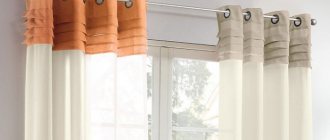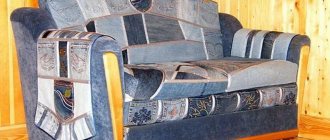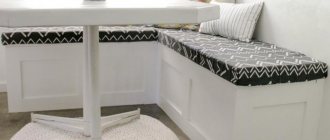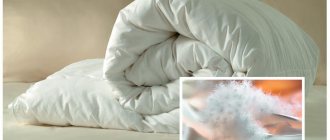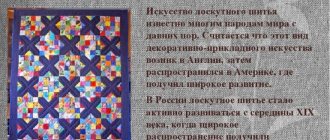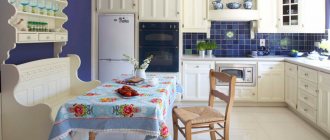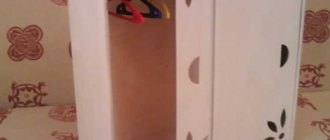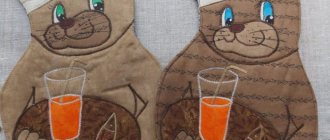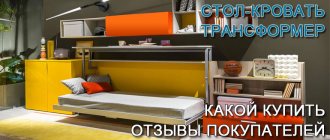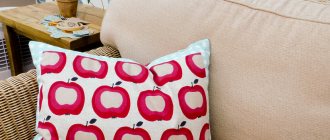The bonbon technique, with which poufs are joined into a single blanket, is vaguely reminiscent of patchwork. The only difference is that the elements are bright small bubble-like elements or small pads. The highlight of this technology is that everyone chooses on their own how to sew a bonbon blanket - make it colored, plain, matte or shiny, large, small, rectangular, square, and so on. There are no restrictions or strict schemes. It all depends on the imagination of the master. It is available for sewing by both experienced and novice dressmakers.
If the fabrics are chosen correctly and the tailoring itself is done carefully, it will be difficult to take your eyes off the finished bonbon product. This material reveals the general principles of the technology, some features and manufacturing options.
How to sew a bonbon blanket?
Blanket dimensions
Despite the fact that there are no strict requirements for the design of bubbles and pillows, it is generally accepted that the minimum and maximum dimensions of the parts will be squares of 8 by 8 cm and 40 by 40, respectively.
If you do not follow this recommendation, the bonbon blanket will look less attractive.
Blanket elements must be the optimal size
Additional functions
The design of the bonbon blanket allows it to be used not only for interior decoration and heating. If there is a child in the house, he can crawl around and spend time actively.
The printed patterns and bright elements of a bonbon blanket are a good alternative to an expensive developmental rug.
The child will love the educational elements of the bonbon blanket
A light bonbon blanket can also serve as a temporary curtain. Its light weight makes it possible to place it as a bedspread on a window or the side of a bed. Sunlight and wind do not penetrate through the fabric and filling, so the bonbon blanket will be good protection from adverse external conditions.
What you need to prepare for sewing
Let's look further at what elements are needed for sewing.
Table 1. List of materials and tools
| Name | Description |
| Base fabric | The components of the blanket will be sewn onto a piece of fabric, so you can even take an old sheet - it still won’t be visible. Any composition is suitable for the base, including simple chintz. In general, there is a recommendation to take a woven fabric of natural origin for that part of the blanket that will always touch the body - satin fabric, linen, or a piece of poplin meet these requirements. |
Fabric for the components of the blanket (they can be bubbles/ottomans or pillows) | Plain, different shades - at the discretion of the master. The front part can be a combination of synthetics and natural fibers. Also, on the outside there can be exclusively synthetic or, on the contrary, natural fabrics. |
Blanket element filler | It is ideal to use padding polyester or holofiber. These materials are lightweight and do not wrinkle during the first wash. Batting warms well but has a number of disadvantages - heavy weight, the ability to retain moisture and accumulate it inside the blanket. In addition, after washing, cotton wool and its derivatives form into clumps, as a result of which the product may lose its appearance. Before you determine the type of filler, you need to think in advance what the mass of the blanket will ultimately be. |
Thick threads | The colors are selected in accordance with the shades of the front side of the blanket (for a variegated model - 2 or 3, for a plain blanket one color is enough). |
Needles | Needed to secure fabric elements. |
Scissors | Will be needed for cutting and other operations. |
Pencil or washable marker, ruler | Needed for marking and defining the boundaries of parts. |
A plain blanket can be attractive too
To make a blanket from bubbles or pillows, you will definitely need a sewing machine.
Machine seams make the product more attractive
What you need to sew a bonbon blanket with your own hands
The bonbon style product consists of two parts: a voluminous outer part and a flat inner part. The first consists of dense squares of fabric with filling, attached to a base. They can be made more voluminous or flat, taking into account your wishes. To create such a blanket you will need:
- fabric for the main layer, at least 1.44 sq. m;
- material for upper pads;
- filler, for example, cotton wool, batting, padding polyester or holofiber;
- ribbons, lace and other trim details;
- sewing equipment for work.
There are many benefits to this type of blanket. It is light weight, warms well, is universal, suitable for both children and adults. It is used as a multifunctional item: a blanket, a bedspread, a throw for a sofa, bed or chair, or a children's play mat.
Important! Handmade bonbon requires special care, including washing on a delicate level, steaming and flat drying. If you follow the rules, such a bedspread will last as long as possible.
Sewing materials
What will become the main fabric when cutting and sewing a bonbon blanket depends on the purpose and manufacturing technology. If a product made using the bonbon technique plays exclusively the role of decoration, a smooth fabric with a characteristic shine and attractive texture would be a good choice. satin , polished poplin , and crepe-satin to create a blanket . cambric and staple , stretch are suitable materials for decorative blankets using the bonbon technique .
Matte and shiny fabrics are equally good in the bonbon technique
When using a blanket for its intended purpose, the ideal option is to sew it from matte natural fabric that is pleasant to the touch, or shiny, but not slippery.
For children, fabrics that are too smooth should not be used and it is advisable to avoid synthetic options when sewing children's products.
Colorful models - for the most daring lovers of experiments
When choosing a material, they also take into account whether the sewing machine can handle the sewing. To get poufs, the craftsman needs to sew in folds and use multi-layering. If the machine is the simplest, it may not be able to pull several dense layers.
Traditional sewing machine is suitable for loose fabrics
Sewing machine prices
Sewing machine
One of the options, which is a fairly universal and popular solution when using decor using the bonbon technique:
- for the top of the blanket - thin satin fabric, medium-density calico, cambric cut, shirt-type fabric, thin linen (to make the product you need to take a mixed fabric that includes at least thirty percent synthetics). An alternative could also be poplin fiber or other high-quality cotton fabric;
- for the back side of the bonbon blanket, the same options are used as for the top, but it is possible to thicken the product and make it softer using flannel, flannelette, cotton velor or cotton velor;
- if there is a layer between the front side and the lining, any material based on cotton will do.
The quality of the material is especially important for children's models
How to choose fabric for a bonbon blanket
For sewing, it is better to choose fairly dense natural materials, it is good if they are cotton. Synthetic fabric is also suitable for the front side, since this part comes into least contact with the skin. You can choose any material as a base, for example, simple chintz; it will not be visible, since the blanket squares are sewn onto it. For the part that will always touch the body, buy linen, poplin or satin fabric. The color of the material can be any at the discretion of the master, for example, plain or with a print. The most impressive look is a voluminous bonbon blanket made of fabric of different shades that combine with each other.
What to fill the blanket with
Among the most popular fillers when sewing products using the bonbon technique is a marshmallow blanket with high-quality filler
It is good to fill a bonbon blanket with such material as Eslon - it has a number of other names: comforter, down. This filler has similar properties to the above-mentioned padding polyester and holofiber.
Marshmallow blanket with quality filling
In texture, Eslon consists of balls that are distinguished by their elasticity and elasticity. They are delicate, have a twisted hollow spiral structure, which does not deform during use and always quickly restores its original appearance. The silicone coating of the balls allows the filler parts to move freely relative to each other and helps maintain the appearance of the blanket.
The amount of filler regulates the splendor of the product
These qualities of Eslon are useful, as they deprive the craftsman of the need to stitch the filler before using it in the product. Also, Eslon does not belong to the group of flammable nonwoven materials; it creates an excellent microclimate in the product, preventing the accumulation of harmful substances in it and the appearance of microorganisms that can negatively affect human health.
Eslon is good to use in bed
Also, the filler of this group does not cause allergies, odors do not accumulate in it. From the point of view of insulation, Eslon also shows itself positively - the material retains heat excellently. Great news for those who care about the health and appearance of things - ticks and moths do not linger in a bonbon blanket with the latest generation of filling.
When storing blankets, they do not accumulate odors
In addition, blankets with Eslon are easy to wash in warm water. Such things will dry quickly in room conditions. Blankets made from ottomans and pillows should be dried in a horizontal plane and protected from direct sunlight.
The blanket should not be exposed to the sun
Design options
Bonbon is a technique that implies the presence of many options for color and texture combinations in one product. You can combine ottomans or pillows in contrasting shades, or, on the contrary, you can create calm combinations. Delicate floral designs and pastoral motifs are good for a bedroom, girl's room or living room with a classic interior. Chocolate and beige make a dynamic and at the same time traditional combination that creates warmth and comfort. Wine shades add chic to the atmosphere.
If you want to create something completely unusual, metallic textures, foil-like fabric, shiny satin and crepe-satin combined with matte details will come to the rescue.
Decorative and functional model option
If the blanket is not intended for use by small children, it can be decorated with a bright edging with rhinestones or sequins.
As for the arrangement of parts by color, it all depends on the choice of the master. He prepares a scheme of color combinations in advance, thinks through how and in what quantity to place squares in a horizontal row, and makes the overall appearance of the product attractive.
Mint or lemon in combination with gray, pink in combination with gold - the color scheme of bonbon blankets can attract attention, relax the eye, and create accents. Considering the volumetric design of the product, it is not only a convenient and functional item, but also takes up enough space in the space, so it is worth considering its appearance in advance.
The texture of the fabric can also serve as decoration
If we talk about the difference between children's and adult models, then lush-looking pillows are more appropriate for the play environment of a children's room. As for the choice of colors, all kinds of bright ottomans, juicy and eye-catching, are suitable for children. You can also opt for calmer pastel options. If the fabric has large prints with famous fairy tale and cartoon characters, you can use a pattern measuring 10 by 10 centimeters or more for the ottomans. Other large patterns that combine with each other are also suitable.
For adults, the decisive factor is the overall style of the room and color in combination with the color schemes of the product.
The size of the squares may vary
Basic sewing techniques
To make a bonbon blanket, there are two main sewing techniques. In both cases, you can sew a blanket either on a sewing machine or by hand (if you don’t have one).
- The first method is to make a product from strips of squares, which are stitched one by one onto the base, and then stitched on three sides, forming pockets into which the filling is placed. At the final stage, the resulting ottomans are stitched on the fourth side.
- The second method is to connect small pre-prepared ottomans, which are then sewn onto the base according to a pre-approved pattern.
General sewing patterns for ribbon type
Cutting and fabric consumption
In order to choose the amount of fabric required for sewing a product, you first need to decide how fluffy it will be. Sewing technology is also taken into account when cutting. Let's look at an example.
If you plan to sew a baby blanket measuring 80 by 110 cm for a crib or stroller, the fabric consumption will be as follows:
Table 2. Required materials
| Name | Consumption |
| Plain fabric for ottomans or multi-colored fabric | Depends on the size of the squares and sewing technology, but there are a number of recommendations. If the structural basis is ribbons, then to the size of the square of the base fabric (where the outer ribbon part is attached) you need to add two or three centimeters on all sides and an additional 1 centimeter for the overlap (to cut out the front squares, cut out the base from thick cardboard and lay it on the fabric ). If we are talking about sewing a blanket from ready-made pillows, then the fabric consumption is also determined by their number and the side of the square. |
| Lining material | If a hem is used when sewing, then for the lining side you need a piece measuring 100 by 130-120 centimeters; when using edging, you need a piece of the same size as the final product - 80 by 110 centimeters. |
| Intermediate layer on which the pads are sewn | 80 by 110 cm fabric. |
| Kant | For the edging, you need to purchase a wide bias tape with a total length of 4 meters: (80 cm + 110 cm) * 2 = 4 m (here the length is indicated with a margin), or use a strip of fabric with a width of at least 5 centimeters, the length of such a strip - similar. |
| Holofiber for filling | 700 grams. |
Bright prints of blankets for children's rooms
If you use a frill element instead of a piping, you will need to recalculate the amount of fabric consumed when sewing. The length of the strip in this case will be 2-3 times longer than when using edging. It is also worth considering the desired splendor of the decor of the product.
Making a blanket from ribbons
Let's look at how a bonbon blanket is made in the first way - by assembling the product from ribbons. Let's also do this using the example of a blanket that can be placed in a child's bed. It serves as both decoration and insulation during the cold season. An additional function of a bonbon blanket for a child is educational. You can crawl on it, it is interesting to hide in it, but at the same time it is not heavy if it is made of fabric stuffed with modern insulation.
Finished blanket
Stage 1. Selecting materials for sewing a bonbon blanket
The size of the final product is 80 by 110 cm. This size is well suited for children's furniture.
At the first step, you will need to prepare pieces of fabric of different colors, as well as internal filler, which will create volume for the finished product.
You will need:
- 3 cotton colors for bombons;
- base for a blanket for the back side measuring 100 by 120 centimeters (if you need a blanket without edging, then for sewing take another piece of fabric for the back of the base with similar sides - the parts are sewn together, in the photo - the finished product processed in the second way);
- filler in quantity 700 grams.
Quality filler is an important factor
You also need threads, stationery for marking, pins, scissors, and a sewing machine.
You need to lay out the available cuts in front of you and choose the best combinations. For a child model, these can be discreet, gentle combinations, unlike the more contrasting ones for adults. Bright colors can be a good choice for children whose activity needs to be stimulated by bright accents in the interior.
It is better to take dense calico as a basis.
For the base you need to choose dense natural and high-quality fabric
For the inside of the bonbon blanket, which will touch the body, you should use natural fabrics.
Front side materials can be of any color
Decorative materials (ribbons, lace elements, stickers, stripes, etc.) can also be useful from raw materials. At the same time, when sewing a baby blanket, you should always remember the safety of the parts. You should avoid elements that can easily come off or injure a child (rhinestones, sequins, etc.).
The product can be decorated in different ways
For sewing, you should take scissors, an iron, pins to secure the fabric, sewing thread, materials for making notes (pencil, chalk, soap). For cutting, you will need paper on which the canvas plan will be drawn.
Stage two. Sketch development
At the next step, the master must transfer the plan of the future bonbon blanket onto paper. It would be nice if the diagram reflected the design of the pattern. In this case, you get 80 squares measuring 11 cm (the blanket consists of 8 squares in width and 10 in length).
The paper will help you visualize the pattern of the blanket
The base fabric can have any color, since sewn pillows filled with padding polyester or holofiber will be placed on top of it. This option comes in three cotton colors.
If you want to make a product of a different size according to this pattern, you need to think about it in advance. It is calculated based on the wishes for the size of the pads. In the children's version, the component parts can have, in particular, dimensions of 6 by 6 cm. Dividing the final length and width of the product by similar indicators of the component pads, we obtain the total number of parts. Or, on the contrary, we add up the overall picture from the sizes of the parts.
At the same stage, the fabric for the base is drawn out for the patch of ottoman parts. It is lined into squares with a side of 11 cm, leaving one centimeter for allowances.
Markings are made directly on the fabric
We must remember that in addition to the squares themselves and the distance between them, the pattern must contain 6 centimeters for allowances (another option is allowances of up to 5 centimeters, but not less than three), folds, and piping to decorate the finished product.
Prices for round cutting knife
Circular knife 45 mm cutting for fabric
Stage three. Preparing the external components of the bonbon blanket
Squares of fabric, cut from sections, are sewn to each other “with a train” so that a ribbon is formed (the stitching is machine-made). Next, the seams between the parts are ironed to the right side. The next ribbon is assembled from squares, stitched, but the seams are ironed to the left, etc. This alternation allows you to achieve a beautiful connection of the ribbons with each other.
The parts are sewn together with ribbons
Next, the resulting ribbons are pinned to the base using “invisible” tapes, forming folds. It is very important to be careful at this step. The appearance of the finished bonbon blanket for a child depends on this.
Sewing is done in a strictly established order
First sew the top of the squares for ottomans along a horizontal line, and then the side seams - in full accordance with what is drawn on the base.
Important. The bottom of the squares is cleaved with the base at the place where the seam allowance strip ends, not the square.
Form folds
Folds can be made in different ways. You can do them inward or in different directions.
The sides are sewn strictly along the seam between the tape parts.
The product must be stitched strictly along the seam
After the so-called “pockets” have been created, they are stuffed with filler (the ottomans should be of medium density) and then the lower part of the tape is attached to the base fabric.
Rows form one after another
The next row is drawn up in the same way until the entire working space of the base is filled. To sew on the next strip, you first need to gather it into folds and then sew it to the first with right sides. You should carefully carry out this operation, getting into the seam lines.
The base consists of rows
At the final stage, you will need to fold the front sides and lining material. They are stitched together along the contour of the ottomans. In order to be able to turn the blanket inside out, leave a 25 cm incision. After this is done, the product is sewn to the end using a hidden seam.
To ensure that sewing requires a minimum number of operations, you can attach the next strip, covering the previous cut site where the soft filler is placed. To sew a blanket in this way, at each stage they make sure that it does not “float”, strengthening the rows with pins or needles.
After all the tapes are in place and the product is ready, the final processing consists of sewing piping on the sides, or stitching the base and bottom layer. Finally, all that remains is to steam the back side, and it is ready for use. You can also decorate the product with satin ribbons.
Recommendation. If you sew an additional layer of padding polyester from the inside out, under such a blanket it will become even more comfortable and warmer.
Blanket made from ready-made “bubbles”
A bonbon blanket can be made up of pillows sewn together.
The set of tools and materials is the same. With the difference that the number of squares should be doubled. A bright fabric is used on the front side, and any other fabric on the back side (it won’t be visible anyway).
Step 1. Forming strips of pads
First, three edges are sewn on each component strip, then filler is placed in the pad and closed with a fourth seam. The same should be done with all pillows, the number of which is determined by the size of the final product.
Pillows are sewn separately
When the blanks are completed, they are connected into strips. It is important that they are smooth and do not create distortions. When stitching, corner should meet corner. It is advisable to first make a basting, and then go through the main seam.
Step 2. Obtaining a fabric from strips
Once there are enough stripes for the blanket, the lines are collected into a large canvas. The base is additionally stitched. The alternation of colors and the number of parts in length and width are thought out in advance.
Assembly
Step 3. The pillows are “planted” on the base , which can be additionally insulated with several layers of padding polyester. Any natural dense fabric can be used as a base. Also, the perimeter of the base fabric can be decorated with frills, borders, etc.
Forming the Foundation
Step 4. Both parts are connected . The result is a comfortable blanket that can also be very warm.
Finished product
How to make a bonbon blanket with your own hands
To make an original bonbon blanket for children or adults, first create a plan for the future product on paper along with a pattern drawing. As a base, choose a fabric with any print, since it will be covered with sewn pads.
How to sew a baby bonbon blanket with your own hands
To make such a thing, you need to take the material for the base and draw it into squares, leaving 5 cm of extra space on each of the four sides. The gap between the rows should be at least 1 cm. Next, draw out the material from which the squares will be cut; be sure to add 6 cm to the specified size for folds and allowance. Each square is sewn to each other so that a ribbon is formed, then the seams are ironed on the right side.
Further algorithm:
- The tape is applied with the outer part to the base fabric, adjusted to one line and stitched on a machine. Then fold the folds vertically and pin them, stitching the seams vertically so that “pockets” are formed. The blanks for the squares should fit snugly against each other
- One strip of pillows is attached to the base with pins and folds are formed. Afterwards, the upper parts of the squares are sewn and side seams are added, which need to be sewn mainly along the seams between the squares.
- The finished holes of the pillows are filled with the selected filler, stitched, and then continue to work according to a similar pattern. The lower part of the strip with pillows must be attached to the base. The amount of filler should be the same in each square
- After sewing on all the squares, the outer side and the lining are folded and stitched along the contour of the resulting pads. It is necessary to select 25 cm of material, which is then turned inside out and stitched to the end using the hidden seam technique. Each tape is carefully straightened around the perimeter of the canvas
- The other strip is first folded and then sewn to the previous strip with the outer part so as to fall into the seam lines.
When the base is ready, all that remains is to supplement it with any decorative details. These are piping, lace, buttons, and much more. To create a blanket for a baby, you can use a more simplified version. The pillow pattern is drawn on paper, having calculated the dimensions and number of squares in advance. During the cutting process, you need to cut out one large square and another smaller one from the material for the lining.
They are pinned with pins, laying a large square in such a way as to make it smaller in size. The pad is stitched, turned inside out, stuffed with filling and sewn up to the end. At the final stage, all the pads are sewn together into one large fabric.
Baby blanket can be used as a play mat
How to sew an adult bonbon blanket
The manufacturing principle of creating an adult blanket is no different from sewing a child’s product. The dimensions of the parts are increased taking into account the needs, making patterns and selecting materials taking into account the design of the future item. The sequence of actions when making a bedspread remains the same; the process of creating the product takes place step by step in accordance with the instructions:
- The necessary materials are purchased for the product; the number of fabrics can consist of two or three samples or more if you need to sew a multi-colored blanket.
- Additionally, if necessary, decorative elements are prepared, for example, satin ribbons and piping, as well as all the tools for work.
- The pattern for the blanket is thought out in advance and a pattern is made, transferring the invented design onto a base in the form of a canvas.
- Ribbons from other fabrics are cut taking into account the type of pattern that should be obtained in the end.
- The finished ribbons are laid out on the base and attached to it using safety pins so as not to knock down the design.
- The first strip is stitched so that its lower part remains empty; visually it should resemble a ribbon of pockets for filler.
- The remaining strips are sewn using the same principle, forming a single fabric of bonbons.
At the final stage, the bedspread is complemented with edging or other decorative elements made from ribbons, edgings and other details. Using this technique, you can sew not only a bedspread for the bedroom, but also a mattress, a rug, or beautiful seats for kitchen ottomans or chairs.
Bonbon will be a great addition to the living room or bedroom
How to sew a round bonbon blanket
A round bonbon blanket for a boy or girl looks much more impressive than the traditional rectangular model. The process of making it is a little more complicated, to get the perfect result, just follow the step-by-step instructions. As an example, a master class on creating a blanket with a diameter of 100 cm is presented:
- They start sewing the blanket from the middle. A pattern is made from paper in the shape of a circle folded in half. Then they apply it to the main fabric, which also needs to be folded in two layers. Secure with pins and begin to cut out the first circle from the material. Notches are made along the edges using scissors.
- All blanks for the product must be made in the form of trapezoids of various sizes depending on the row of the bedspread. Each trapezoid is cut out from a circle; in a round blanket, the row differs from the previous one in size. Trapezoids must have notches along the edges.
- First you need to make the middle of the blanket from two circles of material sewn together and put the filling inside.
- Next, they begin to sew the parts of the trapezoids together, making sure that their edges match. At the beginning, only three sides are sewn, the bottom is left for filler.
- When the trapezoids for the first row are ready, they are sewn into one circle and attached to the main circle in the middle. Afterwards they are filled with padding polyester or holofiber and the part from below is sewn in.
- Using the method indicated above, create four more rows of trapezoids and sew them to each other from the bottom, forming one large round blanket. It must be remembered that each subsequent row will be larger than the previous one; accordingly, the amount of filler must be increased.
If desired, a round blanket can be supplemented with a decorative frill made from a material of a different shade; part of the fabric is cut out in the form of a ribbon, the edges are overlocked and attached to the edge of the base, forming a beautiful fold
The round bonbon looks impressive and original
Recommendations for making a bonbon blanket
Professionals advise following some recommendations when sewing a blanket using this technique:
- to all seams you need to add from 0.05 to 1 cm or more depending on the type of fabric;
- it is imperative to monitor their quality - even seams are the key to success;
- When sewing, the direction of the ottomans should be taken into account;
- Before cutting, all parts are washed and ironed;
- the appearance of the blanket depends on the folds - one fold forms the product from dome parts, two folds at the edge will give the product’s components the appearance of a cube;
Kids of all ages love bonbon blankets
- if the base is increased to 5 centimeters (in addition to taking allowances into account), shrinkage of the product will not harm the appearance;
- You shouldn’t skimp on the filling – the better quality it is, the more airy the sewn blanket will look;
- the pattern of the blanket can be drawn in advance in a special program for a PC, or you can create a sequence of colors and the arrangement of squares in rows on a sheet of paper - for clarity, you can use colored markers, pencils or felt-tip pens to see what the pattern will be in color;
- For children, it is ideal to make a blanket exclusively from light cotton fabrics - they do not cause allergies and it is pleasant to spend time on them, play, and relax.
Useful ideas
Bonbon blanket patterns and sizes
It’s worth deciding in advance on the sizes for an adult and a child’s bedspread:
- For newborns and preschool children, models with sizes from 70-120x100-140 cm are suitable.
- It is better for teenagers to choose the middle option – 80-120×180-190 cm.
- For adults, the ideal choice would be models with dimensions of 140-180×190-200 cm.
The dimensions of standard pillows for children's blankets are 11x11 cm, for adults 6x6 cm. Below are patterns designed for sewing a children's model with sides of 120x60 cm.
It is better to draw a design diagram for the future blanket in advance. In the process of cutting the fabric, adhere to the specified dimensions. Ready-made squares with filling are tightly attached to each other.
Tips for caring for the product
Despite the delicacy of the design, the bonbon blanket does not require maintenance. The filler, which is located in separate cells, is not prone to deformation or change in location in the product. These blankets are machine washed at 30 degrees. If the bonbon blanket has significant dimensions (more than 2 x 1.3 m), it is better to dry clean this product.
When using cotton wool to fill a blanket, clean it only dry
How to care for a bonbon blanket
This type of product has its own characteristics regarding care. It can only be washed with special products for delicate items, which do not contain aggressive components. The washed blanket is dried mainly on a horizontal surface, spreading it around the entire perimeter and placing each pillow evenly so that the filling does not fall inside.
The product cannot be ironed in the standard mode; it is better to use the “steam boost” option or pass over the surface of the fabric with a steamer. Since the filler is contained in square cells separated from each other, it cannot slide to one side, which makes cleaning much easier. The blanket can be washed in a washing machine at a temperature not exceeding 30 °C. If it is too large, it is better to have it dry cleaned when it gets dirty, so as not to damage the material and internal filling.
